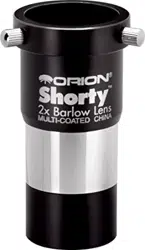
Orion Barlow Lenses
An Orion barlow lens is a simple concave (negative)
lens that amplifies the magnifying power of any tele-
scope eyepiece it’s used with. It works by reducing the
convergence of the light cone heading into the eye-
piece. In this way it increases the focal length of the
telescope. Since magnification is determined by divid-
ing the telescope’s focal length by the eyepiece’s focal
length, you can see that by doubling the telescope’s
focal length, a 2x barlow lens doubles the magnifica-
tion of the system for a given eyepiece.
In this way, a 2x barlow can effectively double the
number of magnifications available to you from a set
of eyepieces. For example, if you have eyepieces with
focal lengths of 26mm, 18mm, and 10mm, using a 2x
barlow will give you the equivalent of 13mm, 9mm,
and 5mm eyepieces—like getting three more eye-
pieces for the price of one barlow!
An Orion barlow lens is an effective means of obtaining higher powers
from short-focal-length telescopes. It also allows use of longer focal-
length eyepieces to achieve a given power.Longer-focal-length eyepieces
usually have longer eye relief than shorter focal-length eyepieces, making
viewing more comfortable. This can be a real benefit for eyeglass wear-
ers, especially, enabling them to see the whole field of view at higher
powers, when normally they cannot.
And there’s another benefit of using a barlow lens: it can actually improve
eyepiece performance, providing sharper images and reducing edge-of-
field optical aberrations.
Use of Orion Barlow Lenses
The barlow lens is typically inserted between the diagonal and the eye-
piece, for refractors and Schmidt-Cassegrain telescopes (Figure A). For
reflectors, the barlow inserts directly into the eyepiece holder of the
focuser drawtube (Figure B). In the position shown in both A and B, a 2x
barlow provides a magnification factor of two, a 3x barlow, a magnification
factor of three, etc.
Alternatively, a barlow lens can be placed before the diagonal, that is,
between the telescope and the diagonal (Figure C). In this case the bar-
low’s magnification factor is increased by about 50%. So a 2x barlow
placed between the telescope and the diagonal provides about a 3x mag-
nification boost. Some barlows will not properly fit after the diagonal, so
this alternate placement is desirable. (Our Shorty barlow, which has a
shorter barrel, fits nicely in most diagonals.) However, be advised that for
some barlow and eyepiece combinations, focus cannot be achieved with
the barlow placed before the diagonal.
Power Limitations
While a barlow lens will increase the magnification of a telescope, there is
a limit to how much magnification is useful. It depends on the telescope’s
aperture, the quality of the optics, and on the outdoor “seeing” conditions,
which vary from night to night.Generally, the maximum practical magnifica-
tion a telescope can deliver is about 50x per inch of aperture (diameter of
the main lens or mirror). Any higher and the images seen will just be blurry
and dim. Seeing conditions (i.e., steadiness of the atmosphere) often limit
the useful magnification to much less than 50x per inch of aperture.
So, for example, if you have a 3” reflector, the maximum useful magnifi-
cation will be about 150x under very steady sky conditions.Say the scope
has a focal length of 700mm; a 10mm eyepiece will provide 70 power.
Using a 2x barlow with that eyepiece would yield 140 power, which is very
close to the scope’s magnification limit under excellent seeing conditions,
and on most nights may simply be too much. Using a 3x barlow would not
be recommended because that would yield 210 power—way too much for
this scope—resulting in a degraded image. You’ll have to experiment on
any given night to see how much power your scope and the prevailing
seeing conditions will permit.
Care of Your Barlow Lens
Care should be exercised when using all optical and mechanical telescope
accessories. Keep your barlow in a protected environment when you’re not
using it. Avoid touching the lenses and coatings. If the outside of the lens
should become dirty, you may want to clean it. Blow off all loose dirt with a
blower bulb. Use only optical lens tissue and good-quality lens fluid. Wet a
folded tissue and gently wipe the surface of the lens. Immediately use a sec-
ond piece of lens tissue to gently dry the lens off. Do not rub or apply
pressure, as this may scratch the lens if dust or grit is present.
One-Year Limited Warranty
Orion Barlow Lenses are warranted against defects in materials or workmanship for a period of one year from the
date of purchase. This warranty is for the benefit of the original retail purchaser only. During this warranty period
Orion Telescopes & Binoculars will repair or replace, at Orion’s option, any warranted instrument that proves to
be defective, provided it is returned postage paid to: Orion Warranty Repair, 89 Hangar Way, Watsonville, CA
95076. If the product is not registered, proof of purchase (such as a copy of the original invoice) is required.
This warranty does not apply if, in Orion’s judgment, the instrument has been abused, mishandled, or modified,
nor does it apply to normal wear and tear. This warranty gives you specific legal rights, and you may also have
other rights, which vary from state to state. For further warranty service information, contact: Customer Service
Department, Orion Telescopes & Binoculars, P. O. Box 1815, Santa Cruz, CA 95061; (800) 676-1343.
IN 017 Rev C 0101
Customer Support (800) 676-1343
E-mail: [email protected]
Corporate Offices (831) 763-7000
P.O. Box 1815, Santa Cruz, CA 95061
Providing Exceptional Consumer Optical Products Since 1975
Figure B:
Barlow in typical
reflector
Figure C:
Barlow placed
before diagonal
(typical refractor)
Figure A:
Barlow placed
after diagonal
